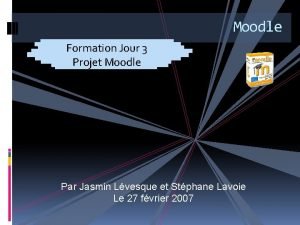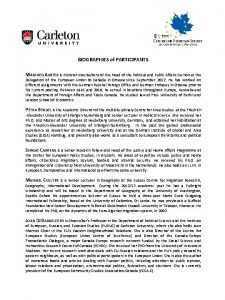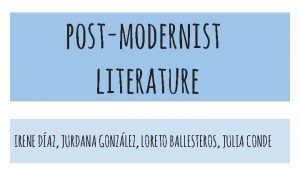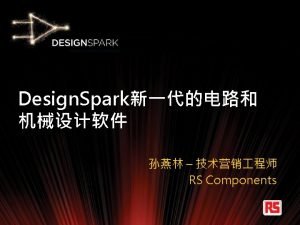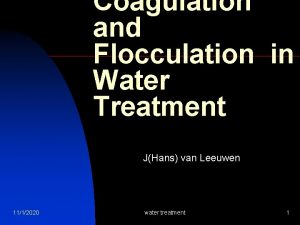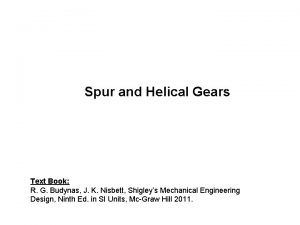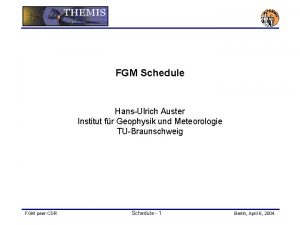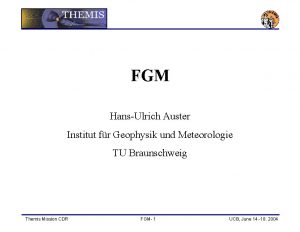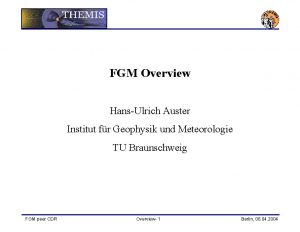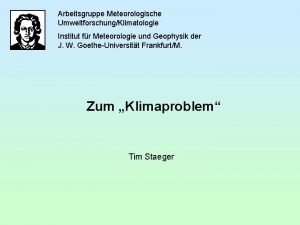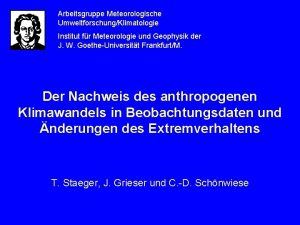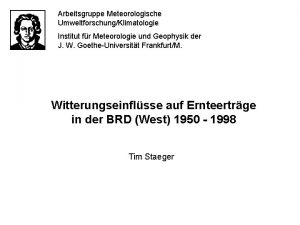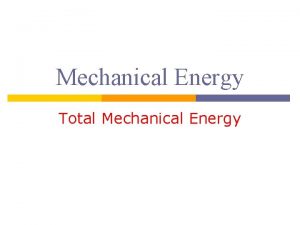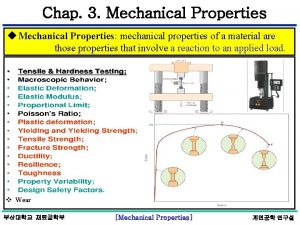FGS Mechanical Design HansUlrich Auster Institut fr Geophysik












- Slides: 12

FGS Mechanical Design Hans-Ulrich Auster Institut für Geophysik und Meteorologie TU Braunschweig FGM peer CDR FGS - 1 Berlin, April 6, 2004

Fluxgate Sensor (FGS) § Sensor design § Summary of PDR presentation § Response to findings § (F 13) Degrading of coating § (F 14) Glue properties § (F 15) CTE of FGS coil system, see presentation of test facilities § (F 16) quasi static vibration levels § FGS test matrix § FGS Harness / Grounding § FGS status FGM peer CDR FGS - 2 Berlin, April 6, 2004

Sensor Design (1) § Vector-compensated Ringcore sensor Two crossed ringcores Material: 6 -81 -Mo Permalloy band non-ferromagn. Ni. Mo 30 alloy Pickup Coil systems Material: Sensitivity: Cu wire isolated by polyesterimid and covered by bond coat (polyamid) about 1, 5 … 3µV/n. T Feedback Coil System Material: Coil const. : CTE: Fixation: FGM peer CDR Cu - wire, see pickup 13 -17000 n. T/m. A about 24 ppm (Cu and Al) by glue (Endfest 300) FGS - 3 Berlin, April 6, 2004

Sensor Design (2) Sensor Hut Interface Material Hut & base plate: Aluminium Isolation: glassfibre reinforced plastics Screws: titanium Washers: glassfibre reinforced plastics Surface (Al): Alodine 1200 Mass: 78 g Mechanical Interface mounting: orientation: four M 4 screws defined by ground plane and two feed side planes (V) Electrical Interface 10 cm pigtail with HD-26 P connector FGM peer CDR FGS - 4 Berlin, April 6, 2004

(F 13) Degrading of coating (F 13): Question coating on wire: polyesterimid, covered by bond coat (polyamid). Is anyone concerned about thermal cycles Themis will experience degrading this coating (especially the innermost probes)? Recommend you compare thermal predictions of # of cycles to environments to which similar coils have been tested/flown. § Experiences onboard MIR station. One year operation in 90 min orbit without thermal isolation. All sensor parameter in nominal range. § Extended test program for spare coils added into test matrix. (5 times between -190°C and +120°C) FGM peer CDR FGS - 5 Berlin, April 6, 2004

(F 14) Glue properties (F 14): Glue is qualified by similarity with another unit which was qualified to 2000 gs. Compare glue patch extents with those of qualified unit. Also, are surface finishes/treatments similar between this unit and the qualified unit? Recommend that the FGM team perform a “liquid nitrogen immersion” test on the flight configuration, with flight-like surface finishes/coatings. § All similar space qualified sensors (Rosetta, Venus Express) are fabricated with the same glue § Surface finishes/treatment has changed between Rosetta (aluminium pure) and Venus Express (aluminium irridite) sensors § liquid nitrogen immersion test will be done with GRM sensor (see test matrix) § Tension tests with glued parts at Bundesanstalt für Materialprüfung FGM peer CDR FGS - 6 Berlin, April 6, 2004

(F 16) quasi static vib. levels Vibration Specs (Qualification): Rosetta - Ariane 5 Venus Express - Sojus/Fregat Sinusoidal Vibration: 5 - 20 Hz: 12 mm 20 26 - 26 Hz: 100 Hz: 1. 5 m/s 25 g Random Vibration, Grms = 18. 07: 20 - 100 Hz: 100 - 400 Hz: 400 - 2000 Hz: +6 d. B/Oct 0. 5 g 2/Hz - 6 d. B/Oct Quasi static acceleration: 25 g (F 16): Stated vibration levels seem very high, but the quasi-static level looks low (25 g). Recommend you set limit loads for the design: if the instruments “are designed to” 100 g, then you are in good shape for levels which fall out of the coupled loads analysis late in project. FGM peer CDR FGS - 7 Berlin, April 6, 2004

(F 16) quasi static vib. levels Results of the sensor modelling (made by IB - Markus Thiel) FGM peer CDR FGS - 8 Berlin, April 6, 2004

Test Matrix FGS Assembly Test name Test description Ringcore selection Ringcores Coils only STM FM 1 -6 Long-term test of ringcores (KHF) Criteria: output voltage, offset, noise X X Parts electr. checkout Resistance of all coils before integration (KHF) X X Coil qualification -190°C / +120°C five times each (BS) Criteria: visual inspection, resistance Coil aging acceptance -40°C / +80°C three times each (BS) Criteria: visual inspection, resistance X X Ringcore checkout Test after integration in pickup coils (KHF). Criteria: output voltage, offset, noise X X FGS electr. checkout Test after sensor integration (KHF) Criteria: Resistance + polarity of all coils X X FGS aging qualification -190°C / +120°C five times each (KHF) Criteria: visual inspection, resistance, output voltage, offset, noise X FGS aging acceptance -40°C / +80°C three times each (KHF) Criteria: visual inspection, resistance, output voltage, offset, noise FGM peer CDR FGS - 9 X X Berlin, April 6, 2004

Test Matrix FGS Test name Test description Vibration TV Calibration STM FM 6 According to qualification levels (UA) According to acceptance levels With Boom X According to qualification levels (WM) According to acceptance levels With Boom FM 1 -5 X X X Berlin / Braunschweig: Offset, noise at room temperature, versus electronics temperature, versus time Graz: Offset, noise, transfer function versus temp Magnetsrode: Scale value, orthogonality versus temp Required temperature range Operation: Survival: Estimation by thermal analysis: FGM peer CDR -100°C … +65°C -79°C … +35°C FGS - 10 Berlin, April 6, 2004

Harness / Grounding § Harness § A/B connector bracket on the boom § C/D connector bracket on the spacecraft FGS sensor pigtail (10 cm) FGS boom harness (2. 49 m) AB FGS electr: harness (1. 2 m) C D connector close to sensor E F FGE connector close to boom hinge § Grounding § Overall shielding connected to S/C ground (chassis) via connector back shells § Sensor aluminum housing, connected to pin 11 of the sensor connector § MLI: inner layer insulating outer layer conductive to boom FGM peer CDR FGS - 11 Berlin, April 6, 2004

FGS Status In time ! FGM peer CDR FGS - 12 Berlin, April 6, 2004
 Icss fgs
Icss fgs Fga montérégie
Fga montérégie Manfred auster
Manfred auster Grundarbeitsfähigkeiten
Grundarbeitsfähigkeiten Paul auster burning boy
Paul auster burning boy Actual mechanical advantage vs ideal mechanical advantage
Actual mechanical advantage vs ideal mechanical advantage Designspark.com
Designspark.com Importance of machine design in mechanical engineering
Importance of machine design in mechanical engineering Hydraulic baffled wall flocculator
Hydraulic baffled wall flocculator Mechanical engineering design book
Mechanical engineering design book Mechanical design of transmission line
Mechanical design of transmission line Machine elements in mechanical design 5th edition
Machine elements in mechanical design 5th edition Balance definition floral design
Balance definition floral design

